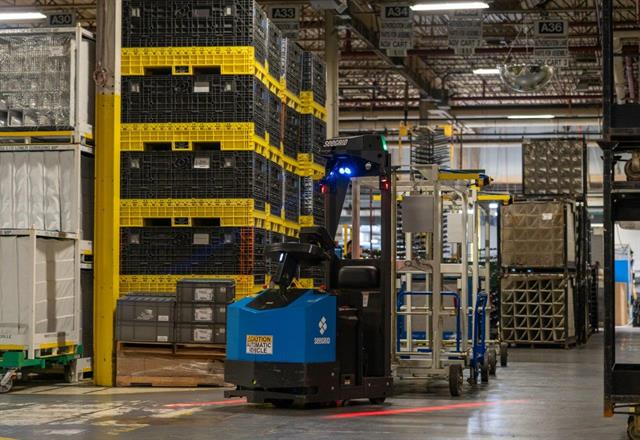 Jeff Christensen
Jeff ChristensenJeff Christensen is vice president of product at Seegrid, a leader in materials handling automation.
Throughout industry, there are a few common myths surrounding automation and jobs. Many fear that technological innovations, specifically automation solutions, will steal human jobs and create a wave of devastating job loss. Others believe that while automation may create jobs, the new positions will require an educational background and skill level many workers simply don’t have.
The truth is that automation does positively impact the job market, and there are many benefits for companies and employees to embrace automation in their facilities.
Here’s how automation creates jobs and leads to greater workplace opportunities for the human workforce.
Addressing shifting workforce demographics and demand
It’s no secret that the American labour pool is shrinking. Baby boomers make up a large portion of the American workforce, and an additional 3 million baby boomers retired in the third quarter of 2020 alone. As the name of this generation implies, those born between 1946 and 1964 were part of a huge population surge that has yet to be replicated. Based on those numbers alone, there are now fewer people of working age for manufacturing and materials handling facility hiring managers to choose from and rely on.
Additionally, there has been a major shift in consumer behaviours and demand. Materials handling facilities used to see predictable seasonal surges in demand and production. To manage peaks in activity, managers would often hire extra temporary staff to get through the busy period. Now, however, every day is like a seasonal surge.
Customers’ reliance on e-commerce spiked during 2020 lockdowns and is showing no sign of waning, according to data from the US Department of Commerce. Additionally, manufacturing corporations’ seasonally adjusted sales for the second quarter of 2021 totalled USD1,800.5 billion, up USD72.1 billion from the first quarter of 2021, and up USD499.5 billion from the second quarter of 2020. For many industries, demand levels continue to surge, leaving facilities scrambling to fill orders in a timely manner with a strained workforce.
Finding, hiring and training staff with the right skill sets is incredibly difficult, as there aren’t enough people to fill current positions. And once a facility has the right staff, there’s the additional challenge of retaining talent.
 Robotics opens the door for more new positions for humans
Robotics opens the door for more new positions for humans
Freeing up human workers for safer, more rewarding jobs
Automation improves operational efficiency and helps close the widening labour gap. With some of the more repetitive, mundane or dangerous work being automated, skilled workers can fill in the labour gaps or take on new opportunities. Workers can then focus on more value-added work for the warehouse or manufacturing facility and enjoy greater job satisfaction. People who enjoy their jobs are more likely to stay for the long term. Companies that invest in training their employees to work alongside and manage automated solutions will reap the rewards of a more efficient and safer workforce.
It's physically impossible for a human worker to surpass the productivity and efficiency of robotic automation. Robots offer accuracy, incredible consistency and unlimited performance that is unmatched by their human counterparts. Plus, robotic automation eliminates human error from the equation, making for a safer environment.
While many fear automation will replace jobs now and in the future, the opposite is actually true. Automating laborious, repetitive materials handling work frees up employees to pursue positions that require imagination and decision-making skills. Additionally, there’s much to be said for the added safety automation affords. The floor of a manufacturing or materials handling facility is incredibly busy and dangerous, and repeating routine tasks over time can cause stress and ergonomic injuries.
To date, Seegrid Palion AMRs have traveled millions of miles without a single personnel safety accident. Robotics ultimately works to drive efficiency, not replace workers. Automation boosts productivity, which allows companies to do more, giving them the resources to create new jobs.
Competing in a technologically advanced market
The Internet of Things (IoT), AI technology, machine learning and other futuristic innovations are advancing the manufacturing and materials handling sectors, a change that’s been dubbed the Fourth Industrial Revolution. According to the 2021 MHI Annual Industry Report, 38% of supply chain leaders already use robotics and automation in their facility. In five years, an additional 38% expect to adopt robotics and automation.
Widespread robot adoption means there is a strategic imperative for companies to introduce technological innovations. No longer can organisations rely on human labour alone to compete in a technologically advanced market; however, that doesn’t mean that humans are obsolete. Robotics opens the door for more new positions for humans. For example, AMR activity can be monitored through analytics software to make sure robots are performing optimally. Data analytics is a booming field that is presenting new and exciting career opportunities for humans.
There is tremendous pressure on materials handling facilities to be competitive on a global scale and keep up with the now constant surges in customer demands. The solution to surpassing the competition and customer expectations is innovation: to solve labour challenges and to grow the business.
There will always be a place for humans
Myths often exist for one very simple reason: because people perpetuate them. There will always be critical roles for the human workforce. When robots manage manual tasks, it boosts reliability and productivity, allowing companies to grow rapidly. Automation and business growth then spawns opportunities for humans to flex the talents they do best — leading, problem solving, and using creativity — to propel operations forward.